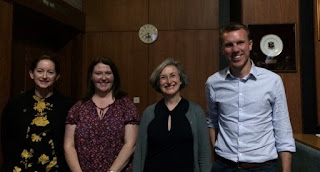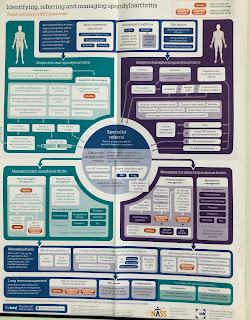Axial Spondyloarthritis
Axial Spondyloarthritis -NASS talk
Glynis gave a presentation on osteopathic treatment of Axial Spondyloarthritis (Axial SpA ,AxSpA) (including Ankylosing Spondylitis AS ) to a mixed group of practitioners on the evening of 17th September. It was hosted by The National Ankylosing Spondylitis Society (NASS) www.nass.co.uk in the Freeman Hospital,Newcastle, as part of a refresher of Axial Spondyloarthritis Axial SpA. In this blog aimed at colleagues she describes how the evening event went.
Why revise your skills in this area of diagnosis ?
There is an 8 and a half year gap between onset of symptoms and diagnosis for people who have Axial SpA . We have the luxury of time and maybe able to use our clinical reasoning to reduce this delay.Interested ?
The evening
This was a first for me speaking to a multi disciplinary group of practitioners. I was very nervous as the time got nearer to the event. Jill from NASS kept smiling at me and even laughed when I made a joke about leaving with my Speaker certificate before the event took place. Apparently this is said by lots of speakers. If any of them disappeared Jill didn’t mention it.
What would a room full or Doctors, Physios and Chiropractors make of what Osteopaths do? Only one way to find out. We had a good turn out of Osteopaths, which made me feel more comfortable. At least they would know what I was talking about . I met two of the other speakers before we started and they were so friendly that I felt much more relaxed.
The Presentation
I was talking using a presentation which had been developed by The Institute of Osteopathy iO and the Royal College of Chiropractors RCC in conjunction with Nass. All of the presentations had been developed to compliment each other, as part of the project . I was able to go through the presentation with osteopath Zöe Clark who designed it. She gave me some tips on what to emphasize and we discussed how she had found her presentation to the Norfolk group.
It was very easy to use. I had a bit of a panic when I came across the word posture. For some reason this had not attracted my attention when I was preparing. During the talk I felt it was necessary to define what I meant by posture during examination. This term is not popular at present as it has connotations of being told to stand up straight and keep your shoulders back. For me posture is a way of understanding how we move and do activities, it’s part of the continuum of living movement. Describing what I thought made up ‘posture’, was very well received especially by the physios.
By engaging with our patients who have Axial Spa the main aims of treatment are three fold firstly to reduce and manage pain, secondly to improve mobility and function, thirdly to educate. The slide representing this in the presentation gave equal importance to hands on treatment, exercise and patient education/advice. This is the main format of all of my patient interactions so resonated very much for me.
Ben Thomson a senior consultant talked about diagnosis and current treatment. He also gave a perspective on how these things had changed overtime.
Zoe Freedman talked about chiropractic treatment and aims.
Maureen Mason a senior physiotherapist in the Freeman’s rheumatology dept talked about the Bath scales used to confirm diagnosis. She also halted to explain Posture. She described posture to her patients as ‘your next movement.’ I am definitely adding this phrase to my descriptive repertoire.
There was a great sense of working together during the evening. There were many similarities between the way physios, chiropractors and osteopaths view what they do to diagnose, give treatment and advice.
Templates to refer patients you suspect may have Axial SpA
In response to the feedback from practitioners a template that osteopaths can use when writing to GPs about their patient having suspected Axial SpA has been developed. This tool has now been endorsed by the Royal College of GPs (RCGP) and Chartered Society for Physiotherapy (CSP); and launched on 15 May 2019 see Your Osteopathy today for details or the links below.
If you would like to find out more you could look through the September/October 2018 issue of Osteopathy Today or follow the links below.
I enjoyed the evening ,it was an excellent opportunity to network with osteopaths and colleagues from other disciplines. I always find it interesting meeting new people especially if I have already had contact on social media. I am going to give the presentation again to a group of Osteopaths in Edinburgh. I think that we will have a very lively discussion.







Comments
Post a Comment